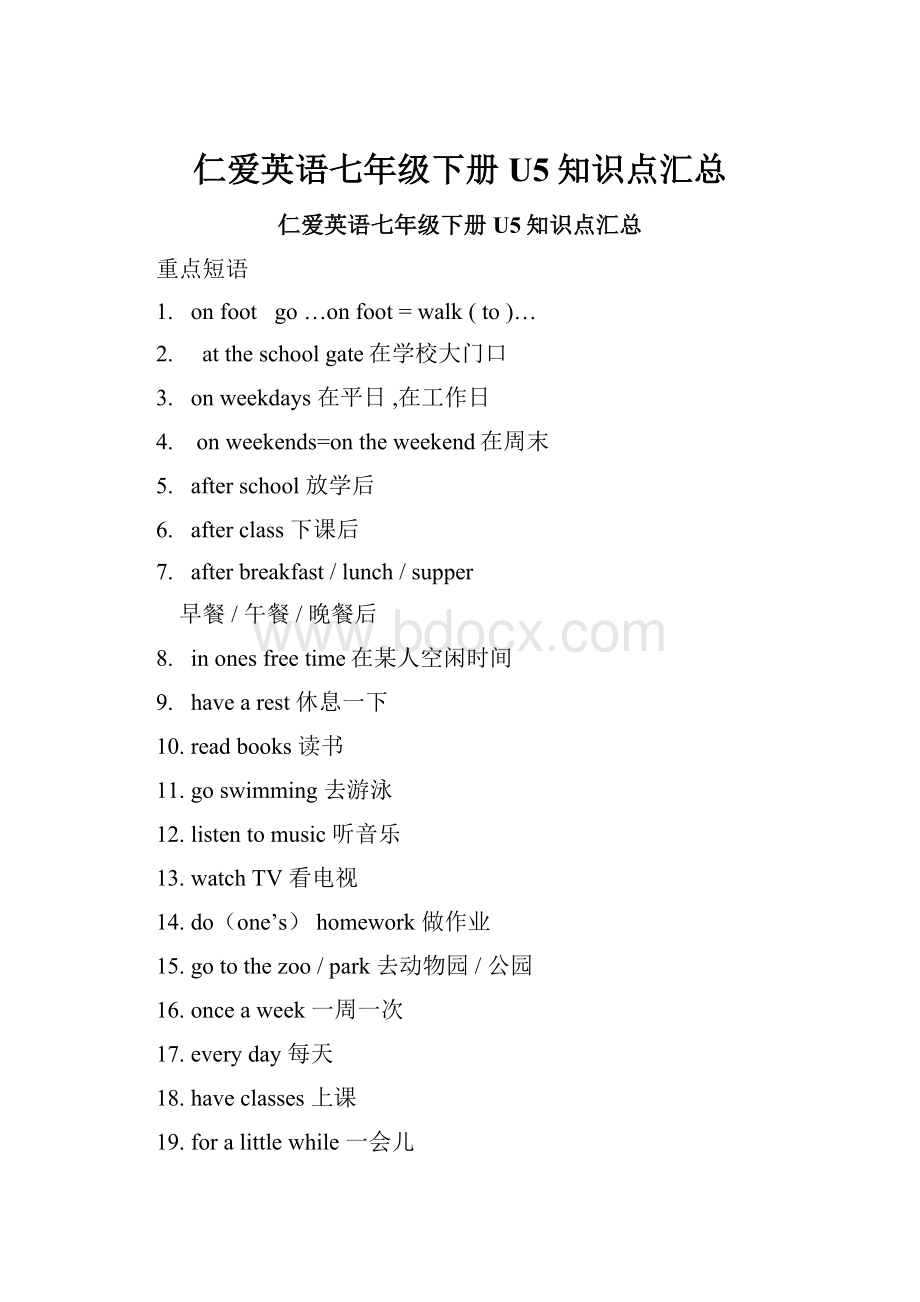仁爱英语七年级下册U5知识点汇总.docx
《仁爱英语七年级下册U5知识点汇总.docx》由会员分享,可在线阅读,更多相关《仁爱英语七年级下册U5知识点汇总.docx(19页珍藏版)》请在冰豆网上搜索。

仁爱英语七年级下册U5知识点汇总
仁爱英语七年级下册U5知识点汇总
重点短语
1. onfoot go…onfoot=walk(to)…
2. attheschoolgate在学校大门口
3. onweekdays 在平日 ,在工作日
4. onweekends=ontheweekend在周末
5. afterschool 放学后
6. afterclass 下课后
7. afterbreakfast/lunch/supper
早餐 / 午餐 / 晚餐后
8. inonesfreetime在某人空闲时间
9. havearest 休息一下
10.readbooks 读书
11.goswimming 去游泳
12.listentomusic 听音乐
13.watchTV 看电视
14.do(one’s) homework 做作业
15.gotothezoo/park 去动物园 / 公园
16.onceaweek 一周一次
17.everyday 每天
18.haveclasses 上课
19.foralittlewhile 一会儿
20.gotobed 上床睡觉
21.comeon 快点,加油,来吧
22.getup 起床
23.talkwith/tosb.与某人谈话
24.atschool 在学校、在上课
25.gotoschool 去上学
26.andsoon……等等
重点句型
1. HappyNewYear!
Thesametoyou.
2. Yournewbikelooksverynice. Thankyou.
3. Howdoyouusuallycometoschool?
—Iusuallycometoschoolbysubway.
4. Howoftendoyougotothelibrary?
5. —Once/Twice/Threetimesaweek/Veryoften/Everyday/Sedom
6. Theearlybirdcatchesthework.(谚语) 笨鸟先飞
7. Work/Studymustcomefirst. 工作/ 学习必须放在第一位!
8. Classesbegin ateight.=Classbeginsateight.
9. Whattimedoestheclassbegin?
/Whattimedotheclassesbegin?
10.Wehavenomoretime. 我们没有更多的时间了。
11.Ihavefourclassesinthemorningandtwointheafternoon.
我早上上四节课,下午上两节。
12.Shegoestobedataboutaquartertoten. 她九点四十五分睡觉。
重点详解
1. by+交通工具,表示使用某种交通方式,中间不加限定词,如果交通工具前有a,the,my 等限定词,就不能用by,而是用in或是on. by+动词ing形式,表示通过某种方式乘坐交通工具
by+交通工具(bycar/bus/train/ship)
takethe+交通工具(takethebus/car)
on+大型封闭式工具(onthebus/train/ship/plane)
onthetrain=bytrain
onhisbike=bybikeonabike/motorbike
in+小型封闭交通工具(inacar/taxi)inmycar=bycar
Ialwayscometoschoolbybus.
Peopleshowlovetotheirmothersbygivingcards.
Youcanbeagoodstudentbyworkinghard.
巧辩异同 onfoot 与 walk onfoot“走路”,是介词短语,不能作谓语,只作方式状语,位于句末。
walk“走路”,是动词,可以作谓语。
takethebus=go…bybus rideabike=go…bybike
takethesubway=go…bysubway
goto…onfoot=walkto Ioftengotoschoolonfoot.=Ioftenwalktoschool.
goto….bybike=rideabike goto….bycar=driveacarto
goto…byplane=flyto goto…bybus=takeabusto
2. It’stimeforsth.“该做某事了”
=It’stimetodosth.
It’stimeforclass.=It’stimetohaveclass.=It’stimeforhavingclass.
3. look+adj (look感官动词,系动词) 看起来
Hismotherlooksveryyoung.
Theylookverycute.
Herdresslooksverynice.
Youlookverycoolinthiscoat.
look的短语
lookthesame看起来一样
looklike看起来像……
lookfor寻找
lookafter =takecareof 照顾,照料
lookaround/about 四处看看,四下环顾;
lookback 回头看;回顾;
lookout 当心,小心,留神;
lookthrough 浏览,仔细查看;
lookup 查寻,查阅;抬头看
4. doone’shomework 做家庭作业(注:
one’s 要随主语的变化而变化,常用形容词性物主代词my,your,their,our,his,her等)。
domyhomeworkatschool 在学校做作业
5. wanttodosth.“想做某事”,want 后接动词不定式作宾语。
knowabout“了解,知道关于…”。
wewanttoknowabouttheschoollifeofAmericanstudents.
我们想了解一下美国学生的学校生活。
6. 巧辩异同
afew+可数名词 (肯定);一点,一些;
few+可数名词:
(否定)很少,几乎没有
alittle+不可数名词(肯定);一点,一些;
little +不可数名词:
(否定)很少,几乎
little和few作形容词用,都表示“几乎没有”,强调少;
alittle和afew强调有一些。
e.g.Hehasafewfriends. 他有几个朋友。
Hehasfewfriends. 他几乎没有朋友。
e.g.IcanspeakonlyalittleChinese.
Theyhaslittlemoney. 他们没有什麽钱
alittle 与 little 也可以用作副词,表示“有点”“稍稍” 表示“很少”
e.g.CanyouspeakEnglish?
---Yes,butonlyalittle.
Thisbookisalittlemoredifficultthanthatone. (可修饰形容词比较级)
Shesleptlittlelastnight. 昨天晚上,她没有怎么睡觉。
7.go+v.-ing 表示去做某事,类似:
gofishing 去钓鱼 goshopping 去买东西
goboating 去划船 goskating 去滑冰 goswimming 去游泳
andsoon“等等”,表示还有很多。
Theyoftenplaybasketballorcoccer,goswimmingandsoon.
8.
(1). Howoften 多久一次(对频度进行提问)
答语常用频度副词always>usually>often>sometimes>seldom>never等或单位时间内的次数,表示频率的短语:
次数+单位时间
e.g.:
onceaweek一周一次 twiceamonth每月两次threetimesayear每年三次
Howoftendoyougotothelibrary?
你多久去一次图书馆?
--once/twice/threetimes/fourtimesaweek/month/year
(2).Howfar多远(表示距离)Howfarisitfromheretothezoo?
--It’s6kilometers.
(3).Howlong多长(对时间进行提问,持续多长时间(多久)/东西的长度(多长)
Howlongdidhestayhere?
Abouttwoweeks.
Howlongistheriver?
About500km.
(4).Howsoon再过多久,主要用来表示对将来一段时间的提问。
常用“in+时间段”来回答。
Howsoonwillhebeback?
Inanhour.
9. over(形容词) School/Classisover. Whattimeistheclassover?
10. begin 现在分词:
beginning 过去式:
began Whattimedoestheclassbegin?
begintodosth begindoingsth
Hebeginstowritealetter.=Hebeginswritingaletter.
如果begin本身为分词,只能用begintodosth Heisbeginningtorun.
11. listento 听(动作), hear 听见(结果)
冠词用法
1. 弹乐器前要带定冠词the,而进行球类运动则不带the。
play+棋类/球类/牌 下……棋,打……球 playsoccer/basketball
playthe+西洋乐器 弹/拉……乐器
playtheguitar/piano
2.序数词,前面要用定冠词the。
onthesecondfloor
3.三餐前面不用冠词。
havebreakfast/lunch/supper
语法:
一般现在时
一般现在时表示:
(常与频度副词never,seldom,sometimes,often,usually,always等连用)
(1)现在所处的状态。
Janeisatschool.
(2)经常或习惯性的动作。
Ioftengotoschoolbybus.
(3)主语具备的性格和能力。
Helikesplayingfootball.
(4)客观真理。
Theearthgoesroundthesun.
常用的时间状语:
often,always,usually,sometimes,everyday等等。
行为动词的一般现在时,助动词是do/don’t和does/doesn’t.当主语是第一、二人称和所有复数形式时,行为动词用原形。
肯定式:
Igotoschoolonfoot. 否定式:
Idon’tgotoschoolonfoot.
疑问式:
Doyougotoschoolonfoot?
—Yes,Ido.—No,Idon’t.
当主语是第三人称单数时,动词用第三人称单数形式,在词尾加-s或-es。
肯定式:
Hegoestoworkbybus.
否定式:
Hedoesn’tgotoworkbybus.
疑问式:
Doeshegotoworkbybus?
—Yes,hedoes.—No,hedoesn’t.
Unit5Topic2
重点短语:
1.makecards 制作卡片
2. on theplayground 在操场上
3. in thelibrary 在图书馆
4. in thegym在体育馆
5. on theshelf在书架上(shelves 复数)
6. at theLostandFound 在失物招领处
7.cleantheroom打扫房间
8.have asoccergame 举行足球比赛
9.have an Englishclass 上英语课
10.writealetter 写信
11.someofhisphotos
=somephotosof his 他的一些照片
12. ontime 准时/intime及时
13.dobetter in sth 在某方面做得较好
14.showsb. around… 带领某人参观……
15. atthemoment“此刻,现在”,=now.
16.planv.计划 plantodosth
17.bekind to sb
=befriendly to sb 对某人很友好
学科名词:
政治:
Politics
语文:
Chinese
数学:
Math
英语:
English
历史:
History
地理:
Geography
生物:
Biology
音乐:
Music
体育:
P.E
美术:
Art
一周名词:
星期一:
Monday
星期二:
Tuesday
星期三;Wednesday
星期四;Thursday
星期五:
Friday
星期六:
Saturday
星期日:
Sunday
重点句型
1.Whatareyoudoing?
---- Heiscleaningthedormitory. 2.Areyoudoingyourhomework?
Yes,Iam./No,Iamnot.
3.HowlongcanIkeepthem?
Twoweeks.
4.Thankyou.---It’sapleasure.
=Apleasure=Mypleasure. 别客气。
5.Sorry,Idon’thaveany.
Thankyouallthesame. 仍然感谢你。
重点详解
1. 巧辩异同
① gotobed“上床”“就寝”Ioftengotobedatten.
② gotosleep“入睡”“睡着”LastnightIwenttosleepattwoo’clock.
3. 巧辩异同some,afew 与alittle“一些,有些”三者都修饰名词。
some既可以修饰可数名词又可以修饰不可数名词。
Wewantsomeapplesandsomewater.
afew用在可数名词复数之前
alittle用在不可数名词之前。
Thereareafewbooksandalittlewaterintheclassroom.
4. 与how相关的短语
howoften多常 howmany多少
howmuch多少钱 howold多大
5. Andyoumustreturnthemontime.你必须按时归还它们。
Return意为“归还,回归
① returnsth.tosb.把某物归还某人
=givebacksth.tosb.
② returnto“回到…”,相当于comebackto…
6. talk“交谈”,常用的短语talkto/withsb.“与某人交谈”
Mariaandagirlaretalkingatthelostandfound.
巧辩异同talk,say,speak与tell
(1) talk“交谈”,表示通过谈话方式交换意见、消息等。
(2) speak“说话”,强调开口发声,后常接某种语言。
(3) say “说”,强调所说的话的内容。
(4) tell“告诉”,有时兼含“嘱咐”“命令”等。
tellatruth说真话,tellalie说谎,
tellastory 讲故事等固定搭配。
7.lookfor“寻找”,强调寻找的过程;
find“找到” 发现,强调找的结果。
Ican’tfindmypurseandIamlookingforit.
8. Read,see,lookandwatch
look(at) 看,表动作,不及物动词,后面需加介词at才能跟宾语,指看的动作,
see 看见,指看的结果,
read常指看书、看报纸等,表示阅读
watch看比赛、电视
e.g I can anappleonthetable。
Iwantto thefilmwithyou。
,thereisakiteflyinginthesky。
Please theblackboardcarefully。
Tvtoomuchisbadforyourhealth。
9. Herearesomephotosofhis.这有他的一些照片。
photosofhis是双重所有格。
his是名词性物主代词,后还可以接名词所有格。
afriendofmine我的一个朋友 aclassmateofmybrother’s我弟弟的一个同学
10. 巧辩异同 also与tooalso放在句中,too用于句末。
also意为“也”,常用于be动词和情态动词后面,实义动词的前面。
e.gHelenisalsoastudent. Ihavelonghairandshehaslonghair,too。
11. borrow:
指主语借入 borrowsth.fromsb.
e.gYoucanborrowthisbookfromthelibrary. MayIborrowyoureraser?
lend:
指主语借出 lendsth.tosb./lendsb.sth.
e.gCanyoulendyourcartome?
Theyoftenlendustheirball.
keep 和 borrow,lend 的意思一样,都是表示借的意思, 区别是borrow和lend是
瞬间动词/,短暂性动词,不能跟一段时间连用,而keep是延续性动词,表示借一段时间,
后常跟一段时间
e.gYoumaykeepthisbookfortwoweeks.
borrow借进 lend借出 keep借多久
14. ontime:
准时,强调不早不迟到达 e.gWemustgotoworkontime.
intime:
及时,强调在规定的时间以前到达 Thestudentscangetthereintime.
15. Japanese:
adj 日本的,日本人的,日语的 n.日本人,日语
当Japanese表示日本人时,是可数名词,单复数同形(与Chinese用法相同)
e.gTwoJapaneseandthreeChineseareswimmingintheswimmingpool.
重要句型总结
1. What’sin+sth 表示哪里有什么东西 e.gWhat’sinyourpurse?
钱包里有什么东西?
2. Whatelse 还有别的什么么?
else:
别的,其它的 Whatelsedoyouhave?
Whoelse还有别的什么人么?
Whereelse 还有别的什么地方么?
else除了可以放在疑问词what,who,where等后面,还可以放在不定代词something,anything,nothing,somebody,anybody,nobody后面
e.gIdon’thaveanythingelsetodo. Ican’tseeanybodyelseintheroom.
3. Herearesomephotosofhis.
名词+Of+名词性物主代词/名词所有格----双重所有格
e.g afriendof Sam’s 萨姆的一个朋友 afriendofmine 我的一个朋友
4. lovedoingsth习惯性的爱好和习惯
lovetodosth一次性的动作或目前想做的事
e.gShelovesreadinginbed. Ilovetogoswimmingtoday.
“Like+动词ing”表示“喜欢做某事” Ilikeplayingbasketball.Tomlikeslisteningtomusic.
“Like+to+动词”也表示“喜欢做某事”,
只是“Like+动词ing”表示习惯性动作(也可以说是爱好), 而“Like+to+动词”表示一次性或短暂性的